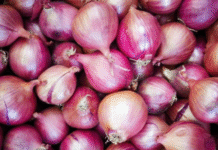
Repeated floods and unfavourable weather are likely to trigger a drop in yield of Aman rice, the second-biggest crop in Bangladesh after Boro, a worrying prospect amid the rising price of the cereal.
The Department of Agricultural Extension (DAE) has targeted to produce 1.56 crore tonnes of rice this season. However, agriculturalists, farmers and rice millers say the overall output may fall short by as much as 25 lakh tonnes.
“We don’t see the prospect of a good harvest of Aman paddy this season. Recurrent floods affected the cultivation in the greater Rangpur division. There were rains almost every day and it caused pest infestation,” said Nirod Boron Saha Chandan, president of the Paddy and Rice Stockists and Wholesalers Association in Naogaon.

Naogaon is one of the main rice-producing districts in the northwest, where repeated floods and heavy rains disrupted timely cultivation.
Officials of the DAE agreed that the yield would drop. They, however, said the production would not decline by more than 5 lakh tonnes this season as the condition of the crop looks good. Production ran into 1.42 crore tonnes last year.
The forecasts came at a time when the price of the staple rice has been rising steadily for a year, hitting the poor, including those who fell into poverty because of the Covid-19-induced economic downturn.
Last month, the Food and Agriculture Organisation (FAO) said the price of rice was more than 25 per cent higher in Dhaka in September than a year earlier.
It said the hike reflected seasonal patterns exacerbated by the concerns over the impact of the inclement weather on the Aman harvest, which accounts for about 35 per cent of the total annual output.
“Yields from this season’s crop are expected to be reduced because of the succession of adverse weather events, starting from excessive precipitation in March and April to tropical cyclone Amphan in May and the recurrent, widespread and severe floods in July and August, which damaged the crop throughout its various development stages,” said the FAO.
Floods began to hit farmers and localities repeatedly from the end of June, largely affecting the cultivation of paddy during the rainy season.
DAE officials said the floods, which hit mainly the northern region for the fifth time this year, affected agricultural production repeatedly. Excessive rains exacerbated the situation.
The floods in the July-August period damaged Aush and Aman crops on 111,000 hectares of area, according to the agriculture ministry.
Another spell of floods in early October and the recent rains resulting from the depression in the Bay of Bengal added further woes for the Aman paddy.
The latest floods and rains completely damaged the Aman crop on 65,000 hectares of land, inflicting a loss of more than 2 lakh tonnes of rice, said DAE Director General Md Asadullah.
“The extent of the damage would be less if there is adequate sunlight,” he said last week.
Farmers have started harvesting the early varieties of Aman and Mohabbat Hossain, a farmer at Dimla in the northwestern district of Nilphamari, said yields would be good in the areas not hit by floods.
“Yet, the overall yield would be below the amount we got in the Aman season last year,” he said over the phone early this week.
Hossain grew Aman on seven acres of land last year. This year, floods damaged cultivation on two acres.
“Many farmers like me could not grow paddy as the floods ruined plantings thrice in our locality,” he said.
Abdul Hannan, a farmer in the northeastern district of Moulvibazar, said floods did not hit Aman cultivation this season. However, the recent rains caused lodging of plants. Plants have also grown larger than expected, he said.
“It appears to me that the overall yield of Aman will be 5-7 lakh tonnes lower than last year’s total,” said KM Layek Ali, general secretary of the Bangladesh Auto Major and Husking Mill Owners Association.
In many areas, especially the low-lying region, farmers could not grow the crop this year, he said.
The latest estimate of the DAE showed that farmers grew Aman paddy on 58.97 lakh hectares and the acreage is higher than the previous year.
Md Shahjahan Kabir, director-general of the Bangladesh Rice Research Institute, said heavy rains affected grain filling. “Late planting will also affect yield.”
Even after the losses, he said, there would be no shortage of the grain, as Bangladesh requires 20 lakh tonnes of rice every month for human consumption.
“So, even if we accept that the yield will be 25 lakh tonnes below last year’s total, there will be no shortage of rice until the harvest of Boro,” he said. The Boro production accounts for 55 per cent of the total annual rice.
Chitta Majumder, managing director of Majumder Group of Industries, said the prices of rice would go up after the harvest of Aman because of lower production.
“Prices are unlikely to cool down without any increase in supply,” he said.
Chandan echoed the same view.
He said farmers would begin the harvesting of Aman after the middle of November and they would be able to make profits even if the government does not buy paddy.
The prices of paddy are unlikely to fall below Tk 1,000 each maund, he said.
“The government is unlikely to attain its target,” he said, suggesting the government reduce the import duty to facilitate imports by the private sector for a short period after the middle of January to contain prices.
The government may consider increasing the import duty again after 15 April, before the beginning of the harvest of Boro paddy, so that farmers do not suffer losses resulting from a huge import, he said.









